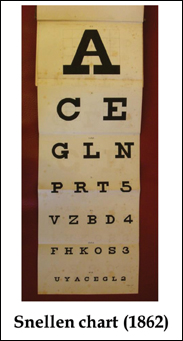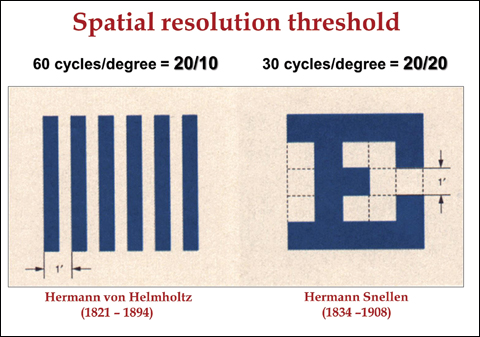Expert considers limits of visual acuity, visibility and optical performance of human eye
Jack T. Holladay, MD, MSEE, FACS, tackles common questions about human vision and visual acuity.

What is the farthest a human can see? What is the best recorded visual acuity? How far is the horizon?
I am often asked these questions by clinicians and non-ophthalmologists and thought many of you might like to know the answers. In this article, we will discuss the limits of visual acuity, visibility and the limiting optical performance of the human eye.
When I am asked, “What is the farthest the eye can see?” I usually reply with a question: “What is the farthest star you can see?” They look puzzled and then I say, “With our naked eye, the farthest star we can see is V762 Cas in the constellation Cassiopeia. It is 16,308 light-years away, and its brightness is magnitude 5.8.” Whether we see a star has nothing to do with its size, but only its perceived brightness. The human eye can see a single candle flickering at 1.6 miles (2.6 km), as shown by Kevin Krisciunas and Don Carona in the astrophysics department at Texas A&M in 2015. So, the farthest we can see a point of light depends on its brightness.
What is the best documented Snellen visual acuity? The limit of best corrected Snellen visual acuity is 20/8.9 (2.25 times better than 20/20), as shown in a study published in 1996 in the American Journal of Ophthalmology about the Los Angeles Dodgers. Pablo Artal a few years ago, at the University of Murcia, Spain, found the best corrected visual acuity using a forced choice “tumbling E” of 20/10. The tumbling E is about one-half a line lower acuity than using Snellen letters because there are fewer clues, so it is harder to guess. Interestingly, of the 600 major and minor league Dodgers tested in the study, 10 (1.7%) had 20/9.2 or better, 253 (42%) had 20/12.5 or better, and 461 (77%) had 20/15 or better, confirming visual acuity is an integral part of baseball.

Images: Holladay JT


What is the limiting factor for visual acuity? The average density of cones in the foveola is 160,000 cones/mm2 but varies widely from 100,000 cones/mm2 to 324,000 cones/mm2, corresponding to visual acuities of 20/10.5 and 20/7.1. These values simply indicate that the aberrations of the eye are the limiting factor and not the retina. So the best recorded Snellen visual acuity of 20/8.9 is limited by the optical aberrations of the eye and is about 2.25 times better than the 20/20 we consider normal (Figure 1). The optimal pupil size for best visual acuity is between 2.5 mm and 3 mm. A smaller pupil is limited by diffraction, and a larger pupil increases the effect of optical aberrations.
Snellen made a mistake when designating 20/20 as normal. Marius Hans Erik Tscherning pointed out this error in his book Optique Physiologique in 1898 (Figure 2) in which he showed the difference in the 20/20 found for best eyes by Snellen using letters and that by Helmholtz using line pairs (Figure 3). If Snellen had converted from line pairs properly, normal Snellen acuity would have been 20/10. Tscherning also noted that if a patient only corrects to 20/20, there are defects (aberrations) in the eye that are sufficiently pronounced to be easily established (he predicted aberrometry). The average best corrected Snellen acuity with aspheric monofocal IOLs following cataract surgery is about 20/16, and some exceptional octogenarians or older can still achieve 20/10.
How far should we sit from the TV? The number of pixels on a TV is analogous to photoreceptors in the retina. The world is in ultra HD because real objects are made up of molecules (and atoms) that are much smaller than anything the eye can see. Full HD TV has 1080 pixels over the vertical dimension of the screen. A 100 inch TV has the same number of pixels as the 50 inch, so you can actually sit twice as close to the smaller TV and have the same quality retinal image. When watching TV at your normal viewing distance, if you can see the pixels in the TV, you are too close. Manufacturers recommend sitting from 1.5 to 2.5 times the diagonal dimension of the TV with 1080p HDTV. For a 60 inch diagonal screen size, this is 7.5 to 12.5 feet.
Another common practical measure of visual performance limited by our atmosphere is called visibility. It is measured in distance. Visibility is not a measure of the eye but the clarity of the atmosphere. This term is used by pilots, captains and weather advisories to convey how far away large objects can be seen. It is actually a measure of contrast or large objects we see through the atmosphere that is reduced by light scatter due to atmospheric conditions such as haze and fog. In extremely clean air in Arctic or mountainous areas, the visibility can be up to 100 miles where there are large markers such as mountains or high ridges. Visibility is reduced by air pollution (haze, dry) and high humidity (mist, moist). So, on a clear day in the mountains, “seeing forever” is about 100 miles.
How far is the horizon? The distance to the horizon depends on the height of the observer above sea level. At sea level, the horizon is at a distance of 2.9 miles for someone who is 5 feet 7 inches tall, and from a crow’s nest on a ship at 100 feet, it is 12.2 miles.
From the perspective of the clinician, we should realize excellent normal visual acuity is 20/10, twice as good (three logMAR lines) as the 20/20 line. It is primarily limited by the optical aberrations of the cornea followed by the crystalline lens and not the retina. For most of us, when standing on the beach the horizon is about 3 miles away, on a clear day the farthest we can see the mountains is 100 miles away, and the stars are far beyond our grasp of distance.
- Reference:
- Laby DM, et al. Am J Ophthalmol. 1996;doi:10.1016/S0002-9394(14)72106-3.
- For more information:
- Jack T. Holladay, MD, MSEE, FACS, is a clinical professor of ophthalmology at Baylor College of Medicine and the OSN Optics Section Editor. If you have any clinical optics questions, please send them to holladay@docholladay.com. Previous articles in the Clinical Optics 101 series may be found at www.healio.com/ClinicalOptics101.
Disclosure: Holladay is a consultant to Abbott Medical Optics, AcuFocus, Alcon Laboratories, ArcScan, Calhoun Vision, Carl Zeiss, Elenza, Oculus and Visiometrics.
